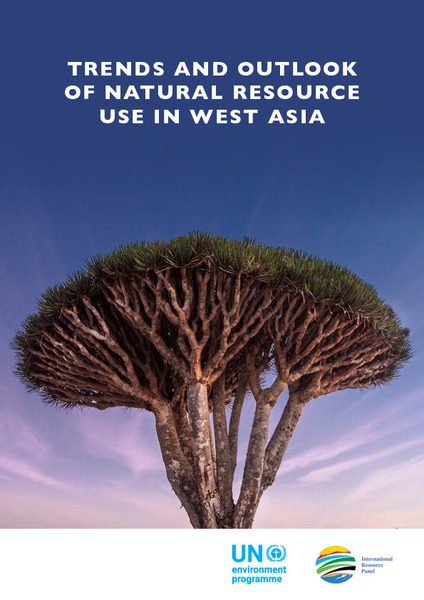Trends and Outlook of Natural Resource Use in West Asia
| dc.contributor | West Asia Office | en_US |
| dc.contributor.author | United Nations Environment Programme | en_US |
| dc.contributor.author | International Resource Panel | en_US |
| dc.coverage.spatial | Bahrain | en_US |
| dc.coverage.spatial | Iraq | en_US |
| dc.coverage.spatial | Jordan | en_US |
| dc.coverage.spatial | Kuwait | en_US |
| dc.coverage.spatial | Lebanon | en_US |
| dc.coverage.spatial | State of Palestine | en_US |
| dc.coverage.spatial | Qatar | en_US |
| dc.coverage.spatial | Oman | en_US |
| dc.coverage.spatial | Saudi Arabia | en_US |
| dc.coverage.spatial | Syrian Arab Republic | en_US |
| dc.coverage.spatial | United Arab Emirates | en_US |
| dc.coverage.spatial | Yemen | en_US |
| dc.coverage.spatial | Asia and the Pacific | en_US |
| dc.date.accessioned | 2023-06-20T10:23:07Z | |
| dc.date.available | 2023-06-20T10:23:07Z | |
| dc.date.issued | 2023-06 | |
| dc.identifier.isbn | 978-92-807-4014-1 | en_US |
| dc.identifier.other | ROWA/2512/PA | en_US |
| dc.identifier.uri | https://wedocs.unep.org/20.500.11822/42812 | |
| dc.description | This piece of work is framed by the set of initiatives rolled out by the Global Opportunities for Sustainable Development Goals (GO4SDGs) in West Asia to enhance the knowledge and capacity of policymakers. It is the first attempt at a regional level to translate the “Global Resources Outlook 2019” (GRO 2019) approach and to test the potential of this analytical capability to inform regional and country consultations. The aim of the report is therefore to: • provide information on the regional environmental impacts of natural resource use; • set out the potential outlook for natural resource use and GHG emissions from 2015 to 2060, which includes a “Historical Trends” and a “Towards Sustainability” pathway for using natural resources and the prospects of future use; and therefore • supply the background information for undertaking regional consultations to shape relevant and targeted policies in the region aimed at the sustainable use of resources. This report marks also the first attempt of translating at regional level the methodology underlying the ‘Global Resources Outlook 2019’ (GRO 2019), to amplify the regional perspectives from the insights of the global projections. In order to do that, the study covers the 12 countries served by the UNEP Regional Office for West Asia: Kingdom of Bahrain, Republic of Iraq, The Hashemite Kingdom of Jordan, State of Kuwait, Republic of Lebanon, State of Palestine, State of Qatar, Sultanate of Oman, Kingdom of Saudi Arabia, Syrian Arab Republic, United Arab Emirates and the Republic of Yemen. | en_US |
| dc.format | en_US | |
| dc.language | English | en_US |
| dc.rights | Public | en_US |
| dc.subject | natural resource | en_US |
| dc.subject | sustainable development | en_US |
| dc.subject | greenhouse gas emission | en_US |
| dc.subject | biodiversity loss | en_US |
| dc.subject | biomass | en_US |
| dc.subject | population | en_US |
| dc.subject | economic growth | en_US |
| dc.subject | urban planning | en_US |
| dc.subject | infrastructure | en_US |
| dc.subject | nature conservation | en_US |
| dc.subject | Bahrain | en_US |
| dc.subject | Jordan | en_US |
| dc.subject | Kuwait | en_US |
| dc.subject | Lebanon | en_US |
| dc.subject | State of Palestine | en_US |
| dc.subject | Qatar | en_US |
| dc.subject | Saudi Arabia | en_US |
| dc.subject | Syrian Arab Republic | en_US |
| dc.subject | United Arab Emirates | en_US |
| dc.subject | Yemen | en_US |
| dc.subject | environmental impact | en_US |
| dc.subject | water stress | en_US |
| dc.subject | resource use | en_US |
| dc.subject | economic policy | en_US |
| dc.subject | social policy | en_US |
| dc.subject | Southwest Asia | en_US |
| dc.subject | development policy | en_US |
| dc.subject | environmental policy | en_US |
| dc.title | Trends and Outlook of Natural Resource Use in West Asia | en_US |
| dc.type | Publications | en_US |
| dc.type | Technical Reports | en_US |
| wd.topics | Nature Action | en_US |
| wd.identifier.doi | https://doi.org/10.59117/20.500.11822/42812 |


